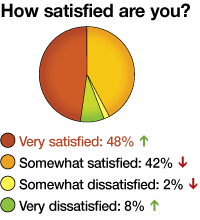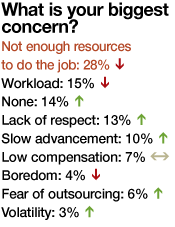How to Defend Your FM Career During Recession
By Naomi Millán, Associate Editor
OTHER PARTS OF THIS ARTICLEPt. 1: This Page
While the rest of the economy might be starting to see the forward glimmer of the light at the end of the recession’s tunnel, the real estate and facilities world will likely lag in recovering. That means facility executives will be faced with tough decisions and slashed budgets for some time yet.
Experts agree that making it through the tough economy requires strategic engagement with the situation. Facility executives who hone their skills and face the challenge with innovation and leadership, can not only survive, but also thrive.
The length of time it takes for developments in the economy to be fully reflected in the facilities world is evidenced by the results of FacilitiesNet.com annual FM Pulse survey. A glance over the surface seems to show little change among big percentages of the population: 79 percent of respondents expect to stay in the same job; 64 percent expect staff sizes to remain the same.
That’s not to say that things are looking rosy in facilities. Consider one symptom of trouble: The number of respondents who expected an increase in staffing dropped from 23 percent in 2008 to 16 percent in 2009. The number of respondents expecting to cut staff increased from 14 percent in 2008 to 20 percent in 2009. And the number of FM professionals expecting to be downsized rose to 10 percent — more than double compared to last year’s survey.
These numbers seem to stem from a common source: the sometimes radical budget cuts and constant calls from upper management for cost-savings from the facilities department. Capital budgets cut in half, revisions to operating budgets, and restrictions on travel, training and utility consumption: The chief imperative for surviving the recession is to stretch every dollar.
“If you’re a facilities management professional, the real trick is to sharpen your pencil,” says Marc Fischer, senior vice president, property management for Transwestern. But before cutting, think about saving. He says that while talking about the energy savings from strategies like putting the blinds down was not sexy back in 2007, now people are paying attention to even the smallest detail.
The options for savings abound. Install occupancy sensors. Don’t run HVAC on the weekend. Install window film. Do a lighting retrofit. It sounds like a broken record. Surely everyone has already deployed these cost-savings strategies in their facilities. Right? Surprisingly, no.
“I’m amazed how much low-hanging fruit people leave on the vine,” Fischer says. For example, when he presents at conferences he asks the audience how many have benchmarked their building with Energy Star and only a third of the room raises a hand. “It’s so simple. Yet so few companies are doing it.”
The no-cost strategies are no-brainers. But even very low-cost strategies might find no audience in this climate.
“Even when a project has less than a one-year payback, they’re saying they don’t have the cash for it,” Fischer says. “Things that two years ago would have been a grand slam home run are not being approved.”
Draw a New Box
Facility executives who are thriving in this economy are using the budgetary pressure as an opportunity for innovation. The name of the game isn’t squeezing services. It’s creatively approaching the problem of how to provide the same value for less money.
“I tell my staff that we have to get around the stereotype that facilities is just an operational and cost-cutting function,” says Robert Barnes, director, corporate services and global facility operations with CIBA VISION. Cutting can become a vicious cycle, he says. “You can get to the point where you’ve pretty much cut to the bone.”
One area where facility executives can explore for savings is in their outsourced service provider relationships. Survey respondents report that 91 percent expect the use of outsourcing to stay the same or increase this year at their facilities. Instead of cutting services, partner with service providers to find ways to reduce costs.
Barnes’ department is piloting a daycleaning program with their cleaning supplier. This creates savings because day porters are no longer needed and improves service because employees can now interact with janitors to give feedback on service level needs.
Another aspect of innovation is doing a serious analysis of the processes within the facilities department to find efficiencies. Fischer says the concept of process innovation was hot in the ‘80s but has since fallen by the wayside. Though it’s a challenge, the tough economy creates an opportunity for change.
“People say, ‘I’ve always done it this way,’” Fischer says. “This is an opportunity to do things differently and find a better way to do it.”
At some point, despite all the best efforts, cuts to services might be inevitable. However, facility executives should maintain a surgeon’s care when making cuts or risk suffering long-term consequences.
“You have to make the implications of cuts clear,” says Stormy Friday, president of The Friday Group. She suggests coming up with different scenarios that show the implications of proposed actions and guiding upper management into decision-making. It’s important to get their buy-in so that when a reduction in service is announced, it’s sanctioned.
Cuts can also have unforeseen consequences, so it’s a good idea to reevaluate the situation every few months to see what impacts the cuts are having and avoid short-sighted strategies, Friday says.
“One of the first things that gets cut is training budgets, but if you do that you pay dearly,” she says. Once the economy improves and the knowledge base for a new piece of equipment or software is needed, it won’t be present in the staff.
Fischer suggests using vendors and trade organizations to provide training. Also, plumb the portfolio for best practices.
One side effect of the recession: facility professionals are going back to school. “They’re now getting credentials and certifications, if they were already in the field and had not done so,” says Friday.
Those credentials have a measurable impact in terms of salary expectations. Respondents to the survey with certification reported a median salary of $84,000, compared to those without, who reported a median salary of $72,000.
Just as individuals are continuing to plan for their futures, a recession is no time for facilities departments to cut back on strategic planning.
“Right now is exactly the time you should be doing strategic planning,” Friday says, “so that when the economy picks back up and your company is bursting out the door, you can keep up.”
Beyond the Money
Historically, job satisfaction has been very high in facilities — and that hasn’t changed. In the FM Pulse survey, 90 percent of respondents reported being at least somewhat, if not very, satisfied with their jobs. Last year, satisfaction was at 91 percent. That satisfaction shouldn’t be allowed to stagnate into complacency, however.
Operating on a tiny budget is just one aspect of navigating a down economy. To succeed, facilities departments have to look beyond themselves and focus on the larger company.
“You need to be in tune with the organization in general,” says Larry Morgan, senior facility manager at SAP Labs. “Take the facilities blinders off. Think of the larger corporate strategies.”
To understand the macroeconomic climate of the company, Morgan suggests looking at the company Web sites and attending as many company functions as possible. The point is to be able to better align the facilities department with the larger company.
Getting that alignment right will help facilities operate in ways that are valuable and tangible to the company. Barnes put that principle into practice. Even with capital budgets cut in half, he was able to get the CEO to OK renovating/relocating the on-site coffee shop. His business case: The headquarters had not been renovated in its 20 years; revamping the popular gathering spot and adding a patio would bolster employee collaboration; revenue could increase. The CEO pounced on the idea.
Facility executives should focus not only on the bottom line but also in terms of growing the revenue, Barnes says. “How does facilities get involved with the top-line focus?”
Morgan suggests finding mentors throughout the organization to help achieve broad perspective.
“You need to network within the organization and within facilities management,” Morgan says. “If you are myopic in this business, you are targeted for removal.”
Cross training within the facilities department is also important because as staff sizes shrink, breadth of knowledge trumps depth.
Sell, Sell, Sell
As important as it is to understand the goals of the larger company, facility executives also need to market themselves and their departments as indispensable to the company. This can be tough for facility executives, who don’t necessarily see themselves as being in public relations, says Friday.
“It’s not just the C-suite you have to cultivate and become visible to,” says Friday. “There are people all over who are movers and shakers. They’re the ones that need to know what you’re doing. They’re the people of influence.” However, facility executives also need to have access to the C-suite, she says, and be able to breeze in and out of it as with any other department.
Being known as the “Johnny on the Spot” department could entail taking on functions that are currently not well-managed or can dovetail with what facilities already does.
“There is no cookie-cutter functionality to facilities management,” Friday says. Functions such as mail or fleet management could come under FM’s purview. Even though it’s extra work, facility executives should be embracing anything they can do to avoid fading into the wallpaper.
At CIBA VISION, Barnes was just designated the executive spokesman for metro Atlanta because he filled a void in community outreach. He works closely with the mayor and city council, and is a member of the chamber of commerce. He positioned the company as the largest corporate purchaser of renewable power in the state, and has played the role of stakeholder in community development plans.
“I became the go-to contact for the community,” Barnes says. “When the community thinks of CIBA VISION, they think of me...the facilities guy!” 
Related Topics:
















